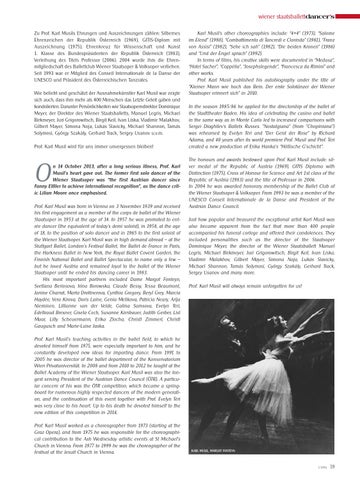wiener staatsballettdancer’s Zu Prof. Karl Musils Ehrungen und Auszeichnungen zählen: Silbernes Ehrenzeichen der Republik Österreich (1969), GITIS-Diplom mit Auszeichnung (1975), Ehrenkreuz für Wissenschaft und Kunst 1. Klasse des Bundespräsidenten der Republik Österreich (1983), Verleihung des Titels Professor (2006). 2004 wurde ihm die Ehrenmitgliedschaft des Ballettclub Wiener Staatsoper & Volksoper verliehen. Seit 1993 war er Mitglied des Conseil Internationale de la Danse der UNESCO und Präsident des Österreichischen Tanzrates. Wie beliebt und geschätzt der Ausnahmekünstler Karl Musil war zeigte sich auch, dass ihm mehr als 400 Menschen das Letzte Geleit gaben und kondolierten. Darunter Persönlichkeiten wie Staatsoperndirektor Dominique Meyer, der Direktor des Wiener Staatsballetts, Manuel Legris, Michael Birkmeyer, Juri Grigorowitsch, Birgit Keil, Ivan Liska, Vladimir Malakhov, Gilbert Mayer, Simona Noja, Lukás Slavicky, Michael Shannon, Tamás Solymosi, György Szakály, Gerhard Track, Sergey Usanov u.v.m. Prof. Karl Musil wird für uns immer unvergessen bleiben!
O
n 14 October 2013, after a long serious illness, Prof. Karl Musil’s heart gave out. The former first solo dancer of the Wiener Staatsoper was “the first Austrian dancer since Fanny Elßler to achieve international recognition”, as the dance critic Lilian Moore once emphasised. Prof. Karl Musil was born in Vienna on 3 November 1939 and received his first engagement as a member of the corps de ballet of the Wiener Staatsoper in 1953 at the age of 14. In 1957 he was promoted to entrée dancer (the equivalent of today’s demi soloist), in 1958, at the age of 18, to the position of solo dancer and in 1965 to the first soloist of the Wiener Staatsoper. Karl Musil was in high demand abroad – at the Stuttgart Ballet, London’s Festival Ballet, the Ballet de France in Paris, the Harkness Ballet in New York, the Royal Ballet Covent Garden, the Finnish National Ballet and Ballet Spectacular, to name only a few – but he loved Austria and remained loyal to the ballet of the Wiener Staatsoper until he ended his dancing career in 1983. His most important partners included Dame Margot Fonteyn, Svetlana Beriosova, Irina Borowska, Claude Bessy, Tessa Beaumont, Janine Charrat, Marta Drottnerova, Cynthia Gregory, Beryl Grey, Marcia Haydée, Vera Kirova, Doris Laine, Genia Melikova, Patricia Neary, Arija Nieminen, Lillianne van der Velde, Galina Samsova, Evelyn Téri, Edeltraud Brexner, Gisela Cech, Susanne Kirnbauer, Judith Gerber, Lisl Maar, Lilly Scheuermann, Erika Zlocha, Christl Zimmerl, Christl Gaugusch and Marie-Luise Jaska.
Karl Musil‘s other choreographies include: “4+4” (1973), “Salome im Elend” (1980), “Combattimento di Tancredi e Clorinda” (1981), “Franz von Assisi” (1982), “Sehe ich sah” (1982), “Die beiden Kronen” (1986) and “Und der Engel sprach” (1992). In terms of films, his creative skills were documented in “Medusa”, “Hotel Sacher”, “Coppélia”, “Josephslegende”, “Francesca da Rimini” and other works. Prof. Karl Musil published his autobiography under the title of “Kleiner Mann wie hoch das Bein. Der erste Solotänzer der Wiener Staatsoper erinnert sich” in 2010. In the season 1985/86 he applied for the directorship of the ballet of the Stadttheater Baden. His idea of celebrating the casino and ballet in the same way as in Monte Carlo led to increased comparisons with Sergei Diaghilev‘s Ballets Russes. ”Nostalgiana” (from ”Chopiniana”) was rehearsed by Evelyn Téri and ”Der Geist der Rose” by Richard Adama, and 40 years after its world premiere Prof. Musil and Prof. Téri created a new production of Erika Hanka’s “Höllische G’schicht ”. The honours and awards bestowed upon Prof. Karl Musil include: silver medal of the Republic of Austria (1969), GITIS Diploma with Distinction (1975), Cross of Honour for Science and Art 1st class of the Republic of Austria (1983) and the title of Professor in 2006. In 2004 he was awarded honorary membership of the Ballet Club of the Wiener Staatsoper & Volksoper. From 1993 he was a member of the UNESCO Conseil Internationale de la Danse and President of the Austrian Dance Council. Just how popular and treasured the exceptional artist Karl Musil was also became apparent from the fact that more than 400 people accompanied his funeral cortege and offered their condolences. They included personalities such as the director of the Staatsoper Dominique Meyer, the director of the Wiener Staatsballett Manuel Legris, Michael Birkmeyer, Juri Grigorowitsch, Birgit Keil, Ivan Liska, Vladimir Malakhov, Gilbert Mayer, Simona Noja, Lukás Slavicky, Michael Shannon, Tamás Solymosi, György Szakály, Gerhard Track, Sergey Usanov and many more. Prof. Karl Musil will always remain unforgotten for us!
Prof. Karl Musil’s teaching activities in the ballet field, to which he devoted himself from 1975, were especially important to him, and he constantly developed new ideas for imparting dance. From 1991 to 2005 he was director of the ballet department of the Konservatorium Wien Privatuniversität. In 2008 and from 2010 to 2012 he taught at the Ballet Academy of the Wiener Staatsoper. Karl Musil was also the longest serving President of the Austrian Dance Council (ÖTR). A particular concern of his was the ÖTR competition, which became a springboard for numerous highly respected dancers of the modern generation, and the continuation of this event together with Prof. Evelyn Téri was very close to his heart. Up to his death he devoted himself to the new edition of this competition in 2014. Prof. Karl Musil worked as a choreographer from 1973 (starting at the Graz Opera), and from 1975 he was responsible for the choreographical contribution to the Ash Wednesday artistic events at St Michael’s Church in Vienna. From 1977 to 1999 he was the choreographer of the festival at the Jesuit Church in Vienna.
KARL MUSIL, MARGOT FONTEYN
1/2014
19
